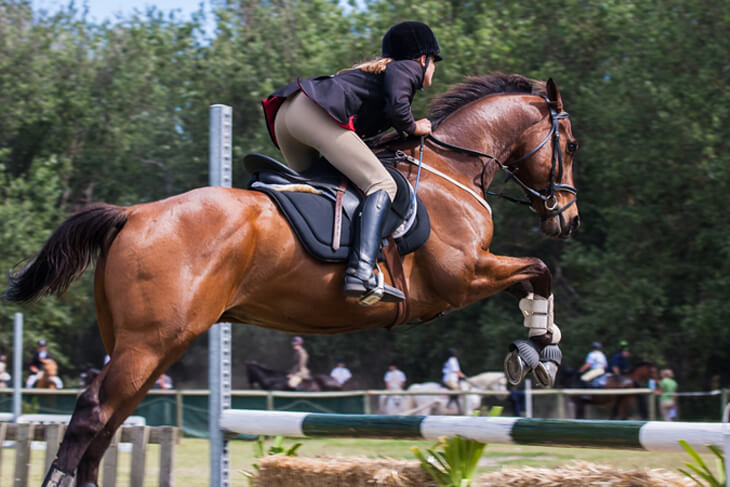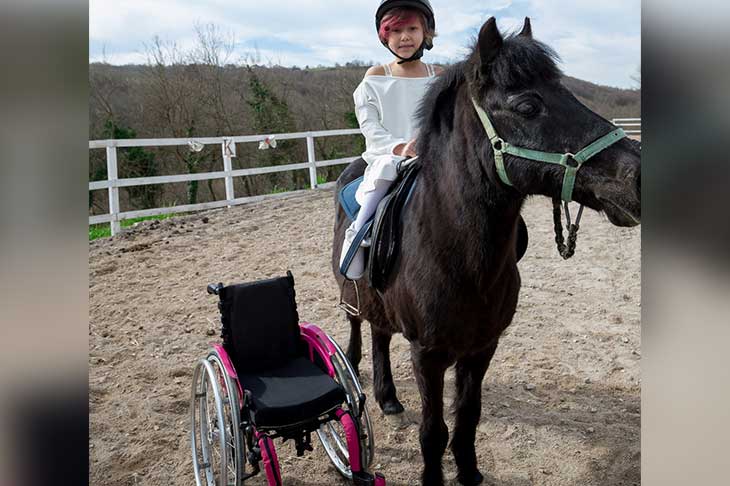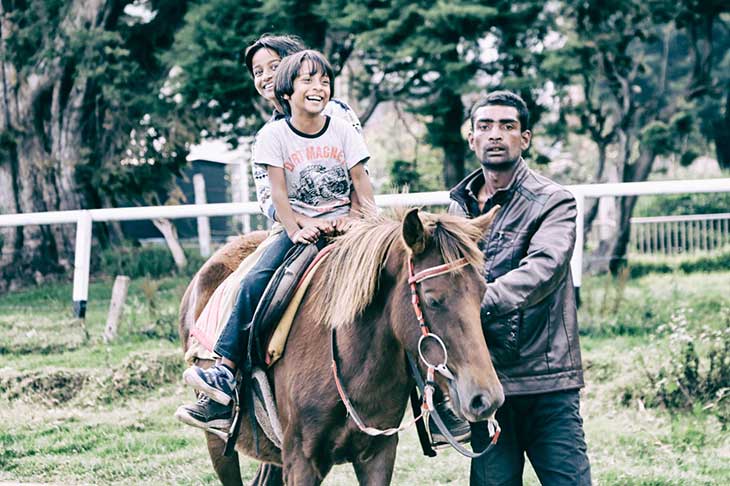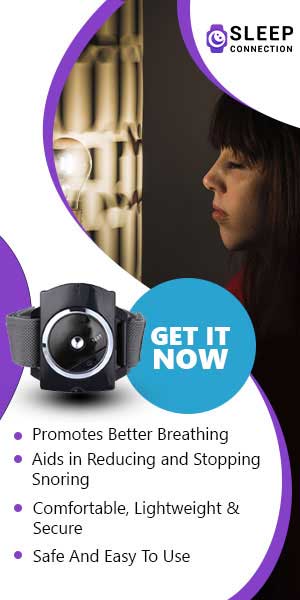
How Horses Help with Therapy
By Anna Swabas Posted 7/28/2021 in LIFESTYLE
Horses are well loved by adults and children alike. Once used mainly as a means of transportation, today they provide enjoyment for riders and horse enthusiasts all over the world. More importantly, they are increasingly being used to provide equine therapy for those with disabilities, especially children.
The history of the horse and its relationship with mankind dates back long before the time of the horse and buggy. According to the World History Encyclopedia, the first written historical record of the relationship between mankind and horses was during the Mesopotamia War in 2400 BC, where they were used to pull chariots. They transitioned to domesticated animals in 2000 BC.

To the Ancient Greeks horses symbolized wealth and elite status. Horses personified a thriving economy as well as warfare. They were also a key part in the civic festivals of ancient times, such as the Panathenaic Games in Athens and the Olympic games at Mt. Olympus. Ancient mythology says that Greek gods and goddesses like Poseidon and Athena held great adoration and appreciation for these beautiful beasts.
In 600 BC. horses began to play a new role in the lives of humans. Orbasis of ancient Lydia documented that horseback riding, now known as equine therapy or therapeutic riding, was a valuable activity for the purpose of mental therapy. Equine therapy was reintroduced in 1946 after the spread of polio in Scandinavia.
In 1960, the United States and Canada began to incorporate therapeutic riding as a means of treatment for people with disabilities. It was formed by the Community Association of Riding of the Disabled (CARD) for educational and therapeutic benefits.
Therapeutic Riding and Equine Assisted Activities Therapy
Great advancements have been made in therapeutic riding since the 60s. It is currently used by mental health professionals as a method to treat physical disabilities like cerebral palsy; developmental disabilities that include autism and down syndrome; and mental and emotional disabilities such as anxiety, ADD, ADHD, and trauma including PTSD.
There are numerous therapeutic riding centers located throughout the world, including the United States, the United Kingdom, and the Philippines. Each center specializes in a particular area of therapeutics, such as equine assisted activities therapy (EAAT) and hippotherapy. Most centers are non-profit organizations which rely heavily on donor support and volunteers.

Therapeutic riding is not considered professional therapy and is not usually covered by health insurance. It is the practice of recreational horseback riding geared for persons with disabilities. Autism, down syndrome, and cerebral palsy are the most common types of special needs treated by therapeutic riding or equine assisted activities therapy.
The Importance of the Horse
Training a horse to work with people who have a variety of disabilities is an important part of equine therapy. They need to have the right temperament and responses to their riders. Horses do not recognize physical disabilities or impairments. Instead, they react to behaviors and emotions of humans.
Horse trainers must ensure these horses possess certain characteristics like good manners. The ability to lead and obey commands are other skill that must be mastered. Horses have to complete four levels of training. The average training time to reach Level IV is a minimum of 12 months.

Horses are innately sensitive animals with a keen sense of observation. Their response to patients is faster and more consistent than that of a therapist. Trained horses are able to mirror the behavior, emotions, and physical movements of their riders, which is crucial in helping patients recognize their own feelings. The instructor is able to decipher the horse’s reactions and provide feedback to the patients. This often validates the feelings of participants affected with mental or emotional pain.
How Horses Help with Physical Disabilities
Riders, or equestrians, with physical disabilities benefit from this type of therapy in three distinctive ways: physically, cognitively, and socio emotionally. Riders show improvement in muscle strength, balance, coordination, endurance, and flexibility thanks to the rhythmic motion that mimics human gait during horseback riding.
This type of therapy is proven to improve muscle tone and range of motion per The Journal of Exercise Rehabilitation (JER). The journal provided research results showing a statistically significant difference in the hip-joint motion range for the knee in children with spastic cerebral palsy.

Additionally, participants in equine assisted activities therapy receive a variety of cognitive benefits such as improved attention, sequencing, memory, communication, spatial awareness, left/right discrimination, and safety awareness. Because of the unique nature of this therapeutic activity, patients learn specific techniques and skills to safely navigate in the meadow that can also be applied in everyday life.
——— ADVERTISEMENT – CONTINUE READING BELOW ———

Social emotional benefits include improved motivation, self-regulation, management of sensory behaviors, self-control, confidence, trust, leadership, and assertiveness. Undoubtedly, the nature of therapeutic riding or equine assisted activities therapy offers a diverse sensory experience for all participants which allows for decreased sensory sensitivities and improvements in sensory seeking behaviors (Holm et al, 2014).
Benefits of Therapeutic Riding for Developmental Disabilities
According to one study, one reason those with autism ( a neurodevelopmental disorder) can benefit from equine assisted activities therapy is because trained horses keep their riders calm. People with autism are able to focus and concentrate when they are in a relaxed state. Their desire to ride and be around horses also encourages positive behaviors while gently discouraging negative behaviors.
Research conducted in 2009 by the Horses and Humans Research Foundation found that autistic children who participated in therapeutic riding demonstrated better sensory seeking and sensitivity. They also exhibited less inattention, distraction, and sedentary behaviors. The research proved that equine therapy is a valuable resource in treating children diagnosed with autism spectrum disorder.

Children with down syndrome also receive positive results from therapeutic riding. Overall motor skills are improved after completing the treatment. Down syndrome is a genetic disorder commonly associated with developmental delays, poor muscle tone, and cognitive impairment. Before participating in equine therapy, it is recommended that x-rays are taken to rule out any signs or symptoms of Atlantoaxial Instability (AAI).
Therapeutic riding requires endurance, muscle strength, coordination of muscles and limbs for sitting up, among many other things. All of which are extremely beneficial for people with down syndrome or anyone with low muscle tone.
Mental and Emotional Disabilities and Equine Therapy
This type of therapy is an excellent resource that is utilized by mental health professionals because it promotes emotional growth in their patients. Since horses display similar social and responsive behaviors as humans, participants in equine therapy are easily able to create a bond with the horses.
Anxiety, depression, and trauma are just a few of the mental and emotional challenges that can be overcome with this type of therapy. Participating in equine therapy allows the opportunity for the patient to use all senses during the learning and healing process. It helps to build self-efficiency, communication, perspective, impulse control, and social skills. It also teaches how to set healthy boundaries.

Equine assisted activities therapy is usually used in conjunction with other well-known treatments. These combined processes are beneficial in producing trust in self, trust in others, and emotional awareness.
Traditional talk therapy with a psychologist or psychiatrist in an office setting is often intimidating, especially to children, teenagers, and young adults. Sharing painful experiences and emotions can feel much less threatening in a group setting, particularly in therapeutic riding. Bonding not only happens with the horse, but with the instructor and other participants as well.
For more information, please visit this website.
What is Hippotherapy?
Hippotherapy is another type of equine therapy. However, it is not horseback riding lessons. It’s physical, occupational or speech therapy using the movement of the horse as the sole treatment tool. It’s a strategic technique used as part of an integrated treatment program to achieve functional goals. Those with neurological or other disabilities such as autism, cerebral palsy, arthritis, spinal cord injury, stroke, behavioral conditions, and psychiatric disorders can all benefit from this method of therapy.
A doctor must first approve this type of treatment. Then the therapist works with a certified horse instructor and a trained therapy horse. Patients always receive direct hands-on participation by the therapist.

The horse’s movement is essential to assist in meeting therapy goals. The goal of hippotherapy is to improve neurological functioning in cognition, body movement, organization, and attention levels. Hippotherapy is a one-on-one treatment and generally occurs until the client meets discharge criteria. In hippotherapy, the attending therapist continually assesses and modifies therapy based on the client’s responses. Due to the physical, occupational or speech therapy needs involved in hippotherapy, it is reimbursable by third party medical insurance.
Please click here to learn more information from the American Hippotherapy Association or to find a list of centers near you.
Organizations such as The Professional Association of the Therapeutic Horsemanship International (PATH Intl.) continue to expand and improve their programs. With continued efforts, more children and young adults with disabilities can look forward to improved physical and mental health.











